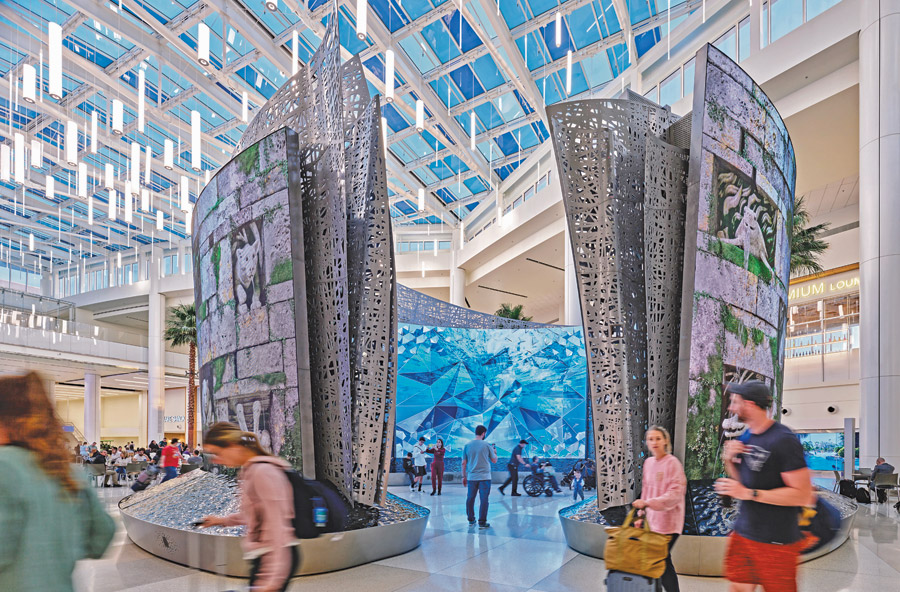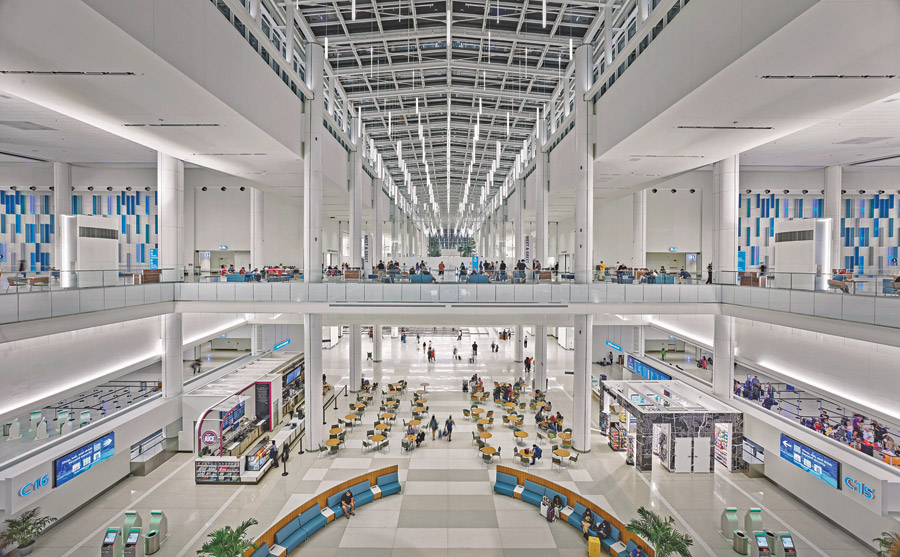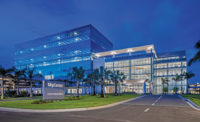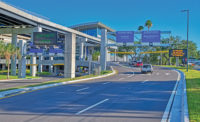Orlando International Airport Terminal C
Orlando
BEST PROJECT, AIRPORT/TRANSIT, and Award of Merit, Excellence In Sustainability
KEY PLAYERS
Submitted by: HNTB
Owner Greater Orlando Aviation Authority
Lead Design Firm Fentress Architects
General Contractors (CMAR) Hensel Phelps; Turner Construction Co.
Structural Engineer C&S Engineers
Airfield Civil Engineer Kimley Horn
Landside Civil Engineer Atkins
Designer of Record HNTB
Electrical Engineer Matern Professional Engineering
Over the six years it took to build Terminal C at Orlando International Airport, the world experienced a crippling pandemic, a precipitous drop and equally sharp rebound in passenger air travel, supply chain disruptions and other issues—all of which compounded the inherent challenges of creating a 1.8-million-sq-ft aviation facility rich in technology and amenities at one of the nation’s fastest growing airports.
But when the $2.8-billion centerpiece of the Greater Orlando Aviation Authority’s 300-acre South Terminal Complex program opened on time and under budget in September 2022, it was largely everything the agency had envisioned—an attractive, efficient and flexible terminal crafted around a Central Florida aesthetic of water, gardens and natural light.
“Perseverance” is how GOAA CEO Kevin Thibault characterizes the effort that kept advancing the project during the months of uncertainty. Thibault, a former state secretary of transportation who joined GOAA in early 2022, adds, “You have to keep going, and you have to identify those things you need to have regardless of the pressures you’ll get or other things that will happen.”
“It’s a credit to the entire team to keep going and exceed all the expectations we had when the project started.”
—Kevin Thibault, CEO, Greater Orlando Aviation Authority
Many of those “need-to-haves” in the completed terminal represent milestones in U.S. passenger aviation operations and technology: 15 common-use swing gates that handle international and domestic flights simultaneously, a 100% trackable baggage system, fully advanced automated security screening lanes and facial recognition “e-gates.” Terminal C also communicates a welcoming “Orlando Experience” sense of place, with a “wow factor” that complements the area’s famed theme parks. The central organizing element is The Boulevard, a 1,000-ft skylit atrium that runs the length of the linear landside facility, creating intuitive wayfinding to ticketing, security and two plaza-style retail areas: Town Square on the landside and Palm Court on the airside concourse hub. Sustainability is likewise incorporated throughout the terminal, from resource-conserving building systems to fully integrated, multimodal connections, including a link to the new Brightline high-speed rail line to South Florida.
Not surprisingly for such a one-of-a-kind facility—GOAA’s largest-ever expansion effort—Terminal C was developed and constructed via a similarly singular delivery approach. Relying largely on state and local funding resources and passenger facility charges (PFCs) rather than federal dollars, Thibault explains, gave the agency “more flexibility in determining the best delivery method for different elements.”
With Fentress Architects as the agency’s lead designer and HNTB serving as architect-of-record, Terminal C’s landside and airside sections were built under separate construction manager at-risk contracts by a Turner Construction-Kiewit joint venture and Hensel Phelps, respectively. Working directly for GOAA, Vanderlande Industries served as design-build-operate-maintain contractor for the baggage handling system, while Burns Engineering was the agency’s prime low-voltage technology engineer.
HNTB senior program director Bill Brooks likens the complex organizational structure to “a choir, and it was very important that we were all on the same page throughout the same program.” Brooks adds that despite their specific roles and often overlapping work scopes, the team members were “really focused on delivering quality on a fast-track [schedule] and keeping the owner’s vision as our vision.”
Co-locating project team leaders, top design and construction subconsultants and other key decision-makers at an onsite trailer village helped facilitate continual communication and consultation for refining project elements, addressing stakeholder needs and avoiding potential workflow conflicts and disruptions.
Turner Construction vice president and general manager Jeff Justen points to Terminal C’s 100% trackable radio-frequency identification baggage handling system, only the second of its kind in the industry, as an example of how communication helped overcome project complexities.
“It was absolutely critical they meet their milestones because of the testing and commissioning requirements,” Justen says. “We would adjust our sequence of flow to make sure they had access to move the project forward. Having a common BIM model to support the day-to-day coordination between superintendents helped avoid potential obstructions and delays.”
Communication across the trailer village and jobsite was a continuation of a fundamental theme fostered at the earliest stages of Terminal C’s design. Fentress Architects founder and principal-in-charge Curtis Fentress recalls how from the outset of the planning and design effort, the design team sought input from every facet of the airport’s existing terminal operations.
“Listening to people who operate the facility is always important,” Fentress says. “Talking with them and reviewing the design with them helped us identify ways to make things more efficient. That includes the things you don’t see as well as the importance of things like retail and making families feel comfortable as they may be waiting several hours for their flight.”

The project creates an “Orlando Experience” with art installations “Windows on Orlando” complementing the area's famed theme parks.
Photo by Michael Robinson, Courtesy of HNTB
The Pandemic Takes Off
Surpassing the milestone of 50 million annual passengers in 2019, the airport’s growth seemed virtually unstoppable until the global coronavirus pandemic spread across the U.S. early the following year. By May 2020, airport traffic had dropped to just a small fraction of the previous year’s volume, shrinking the PFC revenue GOAA was counting on to continue funding what was then only a 60% complete Terminal C.
Anticipating a protracted path back to pre-pandemic passenger counts, GOAA sought to rebalance the project’s budget by deferring elements such as a pedestrian walkway to the Brightline station and a four-gate expansion that had been added to the program after construction began.
“We simply stopped that part of the contract, shored up everything in place and stored the steel and equipment,” Brooks says.
Those materials wouldn’t be idle for long. Florida’s attractions helped fuel a surge in travel through Orlando, enabling GOAA to restore the deferred elements, which are being built by Hensel Phelps under a separate design-bid-build contract and set for completion in 2026.
Brooks says the multiple scope changes “could have been disruptive,” but the overall project was able to carry on, and “we didn’t miss a day during the pandemic.”
GOAA’s pre-pandemic requirement for early purchase of key long-lead materials likewise proved fortuitous, enabling Terminal C to avoid many of the supply chain disruptions and cost increases that plagued other major projects across the U.S. When alternatives for specific types of materials and work-arounds were needed, Justen says, GOAA helped expedite the process of finding suitable solutions with quick decision-making.

The terminal's central organizing element, The Boulevard, a 1,000-ft skylit atrium, provides for intuitive wayfinding to key locations.
Photo by Michael Robinson, Courtesy HNTB
A New Normal
Terminal C’s official opening provided the project team with plenty of accomplishments to celebrate from their six-year effort—moving nearly 4 million cu yd of dirt, erecting more than 61,000 tons of steel and recording 9.1 million work hours with only a 0.26 lost-time accident rate.
The project’s completion also symbolized a reset of sorts for the airport, as the end of 2022 saw annual passenger traffic just shy of the pre-pandemic 50-million milestone. Some of those visitors, Thibault proudly notes, are representatives of other large airports who want a first-hand look at not only Terminal C’s features, but also how they were achieved.
“A project like this has a lot of moving parts,” he says, adding that despite the uncertainties and challenges encountered along the way, “it’s a credit to the entire team to keep going and exceed all the expectations we had when the project started.”
From start to finish, the project team never lost sight of GOAA’s aim for Terminal C to take the “Orlando Experience” to the next level, whether it was through technology features or details such as the 35-ft-tall artificial “forever” trees in the airside Palm Court that repurpose real trees, including bark created from preserved materials.
“You can never lose sight of the fact that this is the owner’s building,” notes HNTB senior program director JC Arteaga, Terminal C’s architect-of-record. “This is their vision; this is what they want.”




Post a comment to this article
Report Abusive Comment